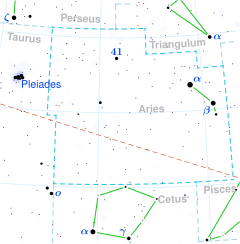Kappa Arietis
| Observation data Epoch J2000.0 Equinox J2000.0 | |
|---|---|
| Constellation | Aries |
| Right ascension | 02h 06m 33.92497s[1] |
| Declination | +22° 38′ 53.9476″[1] |
| Apparent magnitude (V) | 5.02[2] |
| Characteristics | |
| Spectral type | A2m[3] |
| U−B color index | +0.11[2] |
| B−V color index | +0.12[2] |
| Astrometry | |
| Radial velocity (Rv) | +11.5[4] km/s |
| Proper motion (μ) | RA: +20.348[1] mas/yr Dec.: −35.671[1] mas/yr |
| Parallax (π) | 18.0292 ± 0.3092 mas[1] |
| Distance | 181 ± 3 ly (55.5 ± 1.0 pc) |
| Absolute magnitude (MV) | 1.30[3] |
| Orbit[5] | |
| Period (P) | 15.2938 d |
| Eccentricity (e) | 0.61 |
| Periastron epoch (T) | 2,421,844.121 JD |
| Argument of periastron (ω) (secondary) | 358.3° |
| Semi-amplitude (K1) (primary) | 34.5 km/s |
| Semi-amplitude (K2) (secondary) | 35.4 km/s |
| Details | |
| Luminosity | 25[3] L☉ |
| Surface gravity (log g) | 4.0[6] cgs |
| Temperature | 8,700[6] K |
| Metallicity [Fe/H] | +0.18[6] dex |
| Rotational velocity (v sin i) | 18[7] km/s |
| Other designations | |
| Database references | |
| SIMBAD | data |
Kappa Arietis, Latinized from κ Arietis, is the Bayer designation for a binary star in the northern constellation of Aries. The combined apparent visual magnitude of the pair is 5.02,[2] making the system bright enough for it to be dimly visible to the naked eye as a white-hued point of light. It is located approximately 181 light-years from the Sun based on parallax,[1] and is drifting further away with a radial velocity of +11.5 km/s.[4]
The binary nature of this system was announced in 1918 by Lick Observatory. It is a double-lined spectroscopic binary with an orbital period of 15.3 days and an eccentricity of 0.61.[5] Both components displaying the spectral properties of an Am, or metallic-lined star. They have nearly the same brightness and their mass ratio is 1.03; very close to equal.[6]
References
[edit]- ^ a b c d e f Brown, A. G. A.; et al. (Gaia collaboration) (August 2018). "Gaia Data Release 2: Summary of the contents and survey properties". Astronomy & Astrophysics. 616. A1. arXiv:1804.09365. Bibcode:2018A&A...616A...1G. doi:10.1051/0004-6361/201833051. Gaia DR2 record for this source at VizieR.
- ^ a b c d Mendoza, E. E.; et al. (June 1978), "UBVRI photometry of 225 AM stars", Astronomical Journal, 83: 606–614, Bibcode:1978AJ.....83..606M, doi:10.1086/112242.
- ^ a b c Anderson, E.; Francis, Ch. (2012), "XHIP: An extended hipparcos compilation", Astronomy Letters, 38 (5): 331, arXiv:1108.4971, Bibcode:2012AstL...38..331A, doi:10.1134/S1063773712050015, S2CID 119257644.
- ^ a b Wilson, Ralph Elmer (1953), "General Catalogue of Stellar Radial Velocities", Carnegie Institute Washington D.C. Publication, Washington: Carnegie Institution of Washington, Bibcode:1953GCRV..C......0W.
- ^ a b Jones, Rebecca B. (1931), "The orbit of the spectroscopic binary κ Arietis", Lick Observatory Bulletin, 433, Berkeley: University of California Press: 117–122, Bibcode:1931LicOB..15..117J, doi:10.5479/ADS/bib/1931LicOB.15.117J.
- ^ a b c d Mitton, J. (January 1977), "Spectroscopic observations and curve-of-growth analyses of the four A stars omicron Peg, beta Ari, kappa Ari and 32 Vir", Astronomy and Astrophysics Supplement Series, 27: 35–46, Bibcode:1977A&AS...27...35M.
- ^ Royer, F.; et al. (October 2002), "Rotational velocities of A-type stars in the northern hemisphere. II. Measurement of v sin i", Astronomy and Astrophysics, 393: 897–911, arXiv:astro-ph/0205255, Bibcode:2002A&A...393..897R, doi:10.1051/0004-6361:20020943, S2CID 14070763.
- ^ "kap Ari". SIMBAD. Centre de données astronomiques de Strasbourg. Retrieved 2019-09-11.

